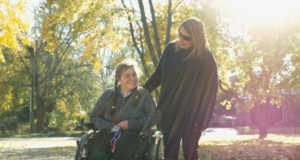Inclusion is a beautiful concept, but…
by Beth
I am delighted to have Patty O’Machel back with us as a guest blogger. Patty is a writer, special needs advocate and mom .
by Patty O’Machel

Patty (right) and her daughter (left)
As a mom, I think about inclusion a lot, and the many variations this word takes in my daughter’s life. As a simple explanation most people think of inclusion when it comes to school and their child’s academic life. School systems and advocates throw this word around a lot, and most fall on one side of the fence or the other when it comes to their feelings on whether kids with disabilities should or should not be included in the typical classroom.
I have seen firsthand the way this looks with my own child, and with other children with disabilities. My daughter is in typical classrooms throughout her whole day at school, but I have seen how some kids with disabilities are shuttled in and out throughout their school day and the strange way this looks for them. They don’t get the same consistent instruction as typical kids, and they get bits and pieces of the whole learning experience. Somehow they are expected to keep up with the lesson plans, and the concept being taught, and make connections with peers — all while not being a real part of the group as a whole. But there also seems to be a pervasive hidden attitude of “that’s ok, because they have disabilities and they wouldn’t be able to keep up anyway.”
This whole arrangement doesn’t seem to benefit the child learner. It may check a box on the IEP, but is it the best situation? Does it give that child the most complete learning experience?
I would say “no.”
My daughter is in class with typical peers throughout her day, but I would have to say that inclusion doesn’t often look like the postcard picture of peers all working together and her being included. She uses a wheelchair, so often in crowded classes she is off in the back or on the side, she is not at a regular desk, and this alone can make things isolating.
She uses her stander in some classes in order to get some stretch to her legs, so that means she is rolled in and “stands” in the back. Not a part of the group, but “in” the classroom.
When they do testing, she is removed to a quiet space or one where her scribe/aide can write or type her work. She works better in smaller groups, and has an easier time sharing her thoughts and being able to keep up — but often these situations make inclusion more difficult.
This term is commonly used speaking only about school and the academic environment, but school is not the only place where kids with disabilities can be included, or excluded. My daughter has a wonderful group of true friends. She loves them, and they love her, too. She has a blast when she is with them, but sometimes that inclusion can be hard. When they “hang out” at one of their houses, those houses are not always accessible. They might have stairs to climb to get inside, or the girls might want to hang out in their rooms or basement, both of which are off limits to my daughter. Or they will go up to town and get food or frozen yogurt, fun if you can walk up to town and get around on your own, but not if you use wheels.
My daughter’s friends never exclude my daughter, but the give and take of normal friendship and interaction is difficult when you are not there.
In order for my teenager to be included, I have to essentially be included as well to manage the logistics — and what teenage group wants a mom hanging around with them all the time?
Inclusion is a beautiful concept. To allow everyone into a group, to be equal and to have everyone have a place and a voice. The concept is lovely. The logistics are often not. Still, as special needs parents, we fight tooth and nail to have our kids be included. We want them to have the same educational experience and to achieve their true potential in everything from friendships to sports to algebra.
As a parent, I sometimes think that my view of inclusion and the school systems’ views are not always aligned. But it is something to strive for and to fight for, and to use our collective voice to have our children know true inclusion in every area of their lives.







August 10th, 2019 at 12:49 pm
I could not agree more. In my view, the resources spent on “inclusion” and other IEP related functions should be pooled and a school specifically designed for “our kids” should be created. My son has Duchenne Muscular Dystrophy and just became non-ambulatory. Inclusion is great, its not just for most of the kids. Furthermore, as you said, it doesn’t serve our kids well.
Marc
Elmhurst
630-915-2885